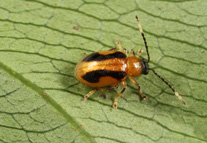Abstract
Kraits with black and white bands from Nui Chua National Park, central Vietnam are morphologically similar to the Burmese Krait, Bungarus magnimaculatus, however, analysis of molecular data finds them to be nested within the B. candidus complex.
References
Boulenger, G.A (1896) Catalogue of the snakes in the British Museum (Natural history). Vol. III. British Museum Natural History, London, 726 pp.
Campden-Main, S.M. (1970) A field guide to the snakes of South Vietnam. Smithsonian Institution, Washington, 114 pp.
Che, J., Chen, H.M., Yang, J.X., Jin, J.Q., Jiang, K., Yuan, Z.Y., Murphy, R.W. & Zhang, Y.P. (2012) Universal COI primers for DNA barcoding amphibians. Molecular Ecology Resource, 12, 247–258.
https://doi.org/10.1111/j.1755-0998.2011.03090.xClare, E.L., Lim, B.K., Fenton, M.B. & Hebert, P.D.N. (2011) Neotropical bats: estimating species diversity with DNA barcodes. PLoS One, 6, e22648.
https://doi.org/1371/journal.pone.0022648Felsenstein, J. (2004) Inferring phylogenies. Sinauer Associates, Sunderland, MA, 580 pp.
Goloboff, P.A., Farris, J.S. & Nixon, K.C. (2008) TNT, a free program for phylogenetic analysis. Cladistics, 24, 774–786.
https://doi.org/10.1111/j.1096-0031.2008.00217.xHanke, M. & Wink, M. (1994) Direct DNA sequencing of PCR-amplified vector inserts following enzymatic degradation of primer and dNTPs. Biotechniques, 17, 858–860.
Herbert, P.D.N, Cywinska, A., Ball, S.L. & de Waard, J.R. (2003) Biological identifications through DNA barcodes. Proceedings of the Royal Society of London B, 270, 313–321.
https://doi.org/10.1098/rspb.2002.2218Hebert, P.D.N., Stoeckle, M.Y., Zemlak, T.S. & Francis, C.M. (2004) Identification of birds through DNA barcodes. PLoS Biology, 2, e312.
https://doi.org/10.1371/journal.pbio.0020312Hebert, P.D.N., de Waard, J.R. & Landry, J.F. (2009) DNA barcodes for 1/1000 of the animal kingdom. Biological Letters,
https://doi.org/10.1098/rsbl.2009.0848Hillis, D.M. & Bull, J.J. (1993) An empirical test of bootstrapping as a method for assessing confidence in phylogenetic analysis. Systematic Biology, 42, 182–192.
https://doi.org/10.1093/sysbio/42.2.182Kimura, M. (1980) A simple method for estimating evolutionary rates of base substitutions through comparative studies of nucleotide sequences. Journal of Molecular Evolution, 16, 111–120.
https://doi.org/10.1007/BF01731581Kuch, U., Kizirian, D., Nguyen, T.Q., Lawson, R., Donnelly, M.A. & Mebs, D. (2005) A new species of krait (Squamata: Elapidae) from the Red River System of northern Vietnam. Copeia, 2005, 818–833.
http://dx. doi.org/10.1643/0045-8511(2005)005[0818:ANSOKS]2.0.CO;2Leviton, A.E., Wogan, G.O.U., Koo, M.S., Zug, G.R., Lucas, R.S. & Vindum, J.V. (2003) The dangerously venomous snakes of Myanmar illustrated checklist with keys. Proceedings of the California Academy of Sciences, 54, 407–462.
Linnaeus, C. (1758) Systema naturæ per regna tria naturæ, secundum classes, ordines, genera, species, cum characteribus, differentiis, synonymis, locis. Tomus I. Editio decima, reformata. 10th Edition. Laurentii Salvii, Holmiæ, 824 pp.
Mabragana, E., Astarloa, J.M.D.A., Hanner, R., Zhang, J. & Castro, M.G. (2011) DNA barcoding identifies argentine fishes from marine and brackish waters. PLoS One, 6, e28655.
https://doi.org/10.1371/journal.pone.0028655
Nagy, Z.T., Sonet, G., Glaw, F. & Vences, M. (2012) First large-scale DNA barcoding assessment of reptiles in the biodiversity hotspot of Madagascar, based on newly designed COI primers. PLoS One, 7, e34506.
https://doi.org/10.1371/journal.pone.0034506
Nylander, J.A.A. (2004) MrModeltest v2. Program distributed by the author. Evolutionary Biology Centre, Uppsala University. [software]
Ronquist, R.R. & Huelsenbeck, J.P. (2003) MrBayes 3: Bayesian phylogenetic inference under mixed models. Bioinformatics, 19, 1572–1574.
https://doi.org/10.1093/bioinformatics/btg180
Sambrook, J., Fritsch, E.F. & Maniatis, T. (1989) Molecular cloning: a laboratory manual. Cold Spring Harbor Laboratory Press, Cold Spring Harbor, New York, 1626 pp.
Slowinski, J.B. (1994) A phylogenetic analysis of Bungarus (Elapidae) based on morphological characters. Journal of Herpetology, 28, 440–446.
https://doi.org/10.2307/1564956Smith, M.A. (1943) The Fauna of British India, Ceylon and Burma, including the whole of the Indo-Chinese subregion. Reptiles and Amphibians. Vol. III. Serpentes. Taylor and Francis Ltd, London, 525 pp.
Song, H., Buhay, J.E., Whiting, M.F. & Crandall, K.A. (2008) Many species in one: DNA barcoding overestimates the number of species when nuclear mitochondrial pseudogenes are coamplified. Proceedings of the National Academy of Science USA, 105, 13486–13491.
https://doi.org/10.1073/pnas.0803076105Stamatakis, A.S., Hoover, P. & Rougemont, J. (2008) A rapid bootstrap algorithm for the RAxML web servers. Systematic Biology, 57, 758–771.
https://doi.org/10.1080/10635150802429642
Tamura, K., Dudley, J., Nei, M. & Kumar, S. (2007) MEGA4: Molecular Evolutionary Genetics Analysis (MEGA) software version 4.0. Molecular Biology and Evolution, 24, 1596–1599.
https://doi.org/10.1093/molbev/msm092
Taylor, E.H. (1965) The serpents of Thailand and adjacent waters. The University of Kansas Science Bulletin, 45, 609–1096.
Thompson, J.D., Higgins, D.G. & Gibson, T.J. (1994) CLUSTAL W: improving the sensitivity of progressive multiple sequence alignment through sequence weighting, position-specific gap penalties and weight matrix choice. Nucleic Acids Research, 22, 4673–4680.
https://doi.org/10.1093/nar/22.22.4673Uetz, P. & Hallermann, J. (2016) The Reptile Database. Available from: http://www.reptile-database.org (accessed 12 July 2016)
Wall, C.F. (1908) A popular treatise of the common Indian snakes. Part VIII. Journal of the Bombay Natural History Society, 18, 711–735.
Wall, F. & Evans, G.H. (1900) Notes on Ophidia collected in Burma from May to December, 1899. Journal of the Bombay Natural History Society, 13, 343–354.
Wall, F. & Evans, G.H. (1901) Burmese snakes: notes on specimens including 45 species of ophidian, fauna collected in Burma from 1st January to 30th June 1900. Journal of the Bombay Natural History Society, 13, 611–620.
Xia, Y., Gu, H.F., Peng, R., Chen, Q., Zheng, Y.C. & Murphy, R.W. (2012) COI is better than 16S rRNA for DNA barcoding Asiatic salamanders (Amphibia: Caudata: Hynobiidae). Molecular Ecology Resources, 12, 48–56.
https://doi.org/10.1111/j.1755-0998.2011.03055.xYan, J., Li, H. & Zhou, K. (2008) Evolution of the mitochondrial genome in snakes: gene rearrangements and phylogenetic relationships. BMC Genomics, 9, 569.
https://doi.org/10.1186/1471-2164-9-569

